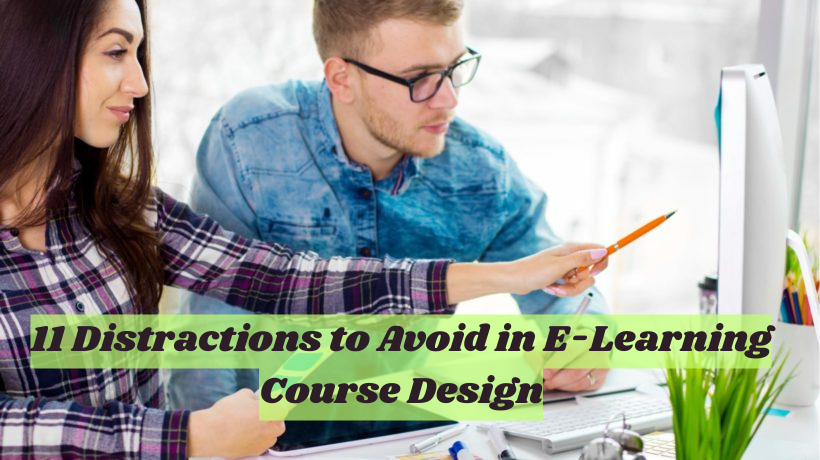11 Distractions to Avoid in E-Learning Course Design
Distractions can significantly impact the effectiveness of e-learning courses and the experience of learners. The problem is that distractions are often hard to identify. After all, nobody would deliberately put a distraction into an e-learning course. More often than not, the distracting element comes with good intentions that are unfortunately misguided.
To avoid interruptions to the learning experience, the following 11 distractions should be avoided or minimised.
Auto-Playing Videos
Videos can enhance the learning experience, but they become a distraction if you set them to play automatically. Auto-playing videos can be particularly jarring if the learner is in a location or situation where they don’t want audio to be heard.
It is much better to leave learners in control of when to play videos, as well as giving them the ability to pause, move backwards and forwards, and control the sound.
Controversial Images
Images are another important feature of e-learning courses, but it is important to be careful when including images that could be considered controversial. The best approach is to consider the backgrounds, locations, and sensitivities of all the learners who will complete your course. Then, if there is any doubt about an image, it is usually best to change it or leave it out altogether.
Background Music
Some people like to learn and work with background music, but it is a completely subjective experience. Even the type of music that is played in the background is subjective. More importantly, background music doesn’t facilitate learning and it is questionable whether or not it contributes to the learning experience. Therefore, it is best avoided.
Hard to Read Text
Hard-to-read text distracts learners as they spend time trying to decipher the text rather than learning. Examples of hard-to-read text that you should avoid include unclear and unusual fonts, large blocks of text, and text that is hard to read because of the colour contrast with the background.
Navigation Overload
Navigational elements are essential in e-learning courses, but it is possible to go too far by including too many buttons, links, and options. The best e-learning course navigation is simple, intuitive, and clear to the point that the learner barely notices it is there. Rather than thinking about navigation, they just progress smoothly through the course.
Unnecessary External Links
External links can be beneficial in e-learning courses, particularly when they add context or additional information. However, it is always important to remember that an external link will take the learner away from the course and the content you want them to learn.
By their very nature, external links are a distraction, so consider the implications before including them. It is also beneficial to consider where to include the links, with the least distracting location often being at the end of the e-learning course.
Too Many Graphs
Graphs are another media element that can facilitate learning and improve the learning experience. However, as with other points on this list, it is possible to go overboard with so many graphs they become a distraction. It is still important to use graphs when appropriate, but make sure you vary the content as much as possible and don’t add too many.
Irrelevant Videos
As videos are one of the most important elements you can include in an e-learning course, it can be tempting to add a video for the sake of adding a video, i.e., rather than for its impact on the learning experience. The problem is that irrelevant videos and videos that don’t enhance the learning experience will only distract learners. It is best to have no videos in your e-learning course at all rather than including one that will be a distraction.
Design Inconsistencies
The overall design of your e-learning course is part of the learning experience, as well as being important for branding reasons. One of the most important things when creating a design is to ensure there is consistency throughout the course on each page, element, and piece of content.
Having this consistency is beneficial for aesthetic reasons and it makes your e-learning course more professional. The opposite, an inconsistent design, is distracting for learners and can make the course less effective.
GIFs
In some situations, GIFs can be used as a light-hearted way to get information across or to make content more entertaining. However, there are also risks when using GIFs, particularly in an e-learning context. GIFs can make the course look unprofessional and there is no way of knowing how a specific GIF will be received. As a result, the best approach is to avoid using GIFs in e-learning courses.
Complex Metaphors
Metaphors can help explain complex topics in a way that resonates and is familiar to learners. However, complex metaphors do the opposite. Instead of the learner learning from the metaphor, they have to spend time trying to understand what the metaphor means. This is a distraction from the learning experience, so complex metaphors should be avoided.
Always Maintain a Learning Focus
What is distracting to one person might be fine for another, so it can be tricky to keep your e-learning courses free from distracting elements. This list is a good starting point. You should also ensure there is a continuous learning focus when creating content and e-learning course designs. If an element could slow down learning or distract some of the learners involved, it is best left out.

